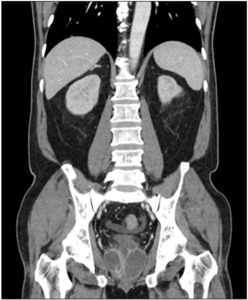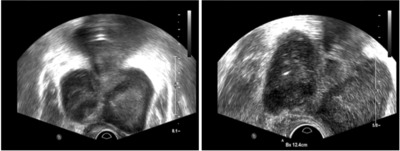Articles
- Page Path
- HOME > Urogenit Tract Infect > Volume 17(1); 2022 > Article
- Original Article Antibiotic Sensitivity of Bacterial Strains from Prostate Abscess Pus Aspirated Using Ultrasound Guidance
-
Kyung Kgi Park
 , Sung Dae Kim
, Sung Dae Kim , Young-Joo Kim
, Young-Joo Kim , Jung-Sik Huh,
, Jung-Sik Huh,
-
Urogenital Tract Infection 2022;17(1):26-30.
DOI: https://doi.org/10.14777/uti.2022.17.1.26
Published online: April 30, 2022
Department of Urology, Jeju National University Hospital, Jeju National University School of Medicine, Jeju, Korea
-
Correspondence to: Jung-Sik Huh,
 , Department of Urology, Jeju National University Hospital, 15 Aran 13-gil, Jeju 63241, Korea, Tel: +82-64-717-1760, Fax: +82-64-717-1131, E-mail: urohjs@jejunu.ac.kr
, Department of Urology, Jeju National University Hospital, 15 Aran 13-gil, Jeju 63241, Korea, Tel: +82-64-717-1760, Fax: +82-64-717-1131, E-mail: urohjs@jejunu.ac.kr
Copyright © 2022, Korean Association of Urogenital Tract Infection and Inflammation. All rights reserved.
This is an open-access article distributed under the terms of the Creative Commons Attribution Non-Commercial License (http://creativecommons.org/licenses/by-nc/4.0) which permits unrestricted non-commercial use, distribution, and reproduction in any medium, provided the original work is properly cited.
- 2,481 Views
- 9 Download
- 2 Crossref
Abstract
-
Purpose A prostate abscess is a rare occurrence often caused by immune dysfunction. The diagnostic modality for a prostate abscess is computed tomography or transrectal ultrasound. Transrectal ultrasound-guided aspiration is one such method. If treatment is dependent on the abscess size. This study examined the bacterial strains drained under transrectal ultrasound and their antibiotic sensitivity.
-
Materials and Methods The medical records of eight patients diagnosed with a prostatic abscess and treated by transrectal ultrasound-guided aspiration from March 2009 to December 2020 were reviewed retrospectively. The general characteristics, associated diseases, and bacterial strains and their antibiotic sensitivities were identified in blood, urine, and pus cultures.
-
Results Eight patients were hospitalized. The average age was 59.5±6.05 years, and the average length of hospitalization was 16.88±5.49 days; 75% had diabetes. No patients had catheterization, spinal injury, or prostate biopsy prior to diagnosis. The mean prostate volume was 47.05±27.3 ml, and the mean prostate abscess size was 2.08±0.83 ml. Under transrectal ultrasonography, the prostate abscess size was 5.43±5.31 ml, and catheters were inserted for treatment in four cases (50%). In the abscess culture test, Escherichia coli, Klebsiella pneumoniae, and Staphylococcus aureus were found in four, three, and one case, respectively. E. coli and K. pneumoniae responded well to amikacin treatment, while seven cases responded well to Piperacillin/Tazobactam treatment.
-
Conclusions Prostate abscesses occur mainly in diabetic patients. The most common cultures are E. coli and K. pneumoniae. Intravenous injection of amikacin or Piperacillin/Tazobactam may be helpful as a treatment prior to bacterial identification.
INTRODUCTION
MATERIALS AND METHODS
RESULTS
DISCUSSION
CONCLUSIONS
-
CONFLICT OF INTEREST
No potential conflict of interest relevant to this article was reported.
-
AUTHOR CONTRIBUTIONS
K.K.P. and J.S.H. participated in data collection and wrote the manuscript. S.D.K. and Y.J.K. participated in the study design and coordination and helped to draft the manuscript. All authors read and approved the final manuscript.
NOTES
- 1. Jang K, Lee DH, Lee SH, Chung BH. Treatment of prostatic abscess: case collection and comparison of treatment methods. Korean J Urol 2012;53:860-4. ArticlePubMedPMC
- 2. Khim G, Em S, Mo S, Townell N. Liver abscess: diagnostic and management issues found in the low resource setting. Br Med Bull 2019;132:45-52. ArticlePubMedPMCPDF
- 3. Roediger R, Lisker-Melman M. Pyogenic and amebic infections of the liver. Gastroenterol Clin North Am 2020;49:361-77. ArticlePubMed
- 4. Feki W, Ketata W, Bahloul N, Ayadi H, Yangui I, Kammoun S. [Lung abscess: diagnosis and management]. Rev Mal Respir 2019;36:707-19; French. PubMed
- 5. Hillejan L. [Management of lung abscess - diagnostics and treatment]. Zentralbl Chir 2020;145:597-609; German. ArticlePubMed
- 6. Trauzzi SJ, Kay CJ, Kaufman DG, Lowe FC. Management of prostatic abscess in patients with human immunodeficiency syndrome. Urology 1994;43:629-33. ArticlePubMed
- 7. Ludwig M, Schroeder-Printzen I, Schiefer HG, Weidner W. Diagnosis and therapeutic management of 18 patients with prostatic abscess. Urology 1999;53:340-5. ArticlePubMed
- 8. Brede CM, Shoskes DA. The etiology and management of acute prostatitis. Nat Rev Urol 2011;8:207-12. ArticlePubMedPDF
- 9. Oliveira P, Andrade JA, Porto HC, Filho JE, Vinhaes AF. Diag-nosis and treatment of prostatic abscess. Int Braz J Urol 2003;29:30-4. ArticlePubMed
- 10. Ha US, Kim ME, Kim CS, Shim BS, Han CH, Lee SD, et al. Acute bacterial prostatitis in Korea: clinical outcome, including symp-toms, management, microbiology and course of disease. Int J Antimicrob Agents 2008;31 Suppl 1:S96-101. ArticlePubMed
- 11. Barozzi L, Pavlica P, Menchi I, De Matteis M, Canepari M. Prostatic abscess: diagnosis and treatment. AJR Am J Roentgenol 1998;170:753-7. ArticlePubMed
- 12. Ackerman AL, Parameshwar PS, Anger JT. Diagnosis and treat-ment of patients with prostatic abscess in the post-antibiotic era. Int J Urol 2018;25:103-10. ArticlePubMedPDF
- 13. Weinberger M, Cytron S, Servadio C, Block C, Rosenfeld JB, Pitlik SD. Prostatic abscess in the antibiotic era. Rev Infect Dis 1988;10:239-49. ArticlePubMed
- 14. Abdelmoteleb H, Rashed F, Hawary A. Management of prostate abscess in the absence of guidelines. Int Braz J Urol 2017;43:835-40. ArticlePubMedPMC
- 15. Oshinomi K, Matsui Y, Unoki T, Shimoyama H, Nakasato T, Morita J, et al. Treatment strategy for prostatic abscess: eighteen cases' report and review of literature. Urol Sci 2018;29:206-9.
- 16. Lee DS, Choe HS, Kim HY, Kim SW, Bae SR, Yoon BI, et al. Acute bacterial prostatitis and abscess formation. BMC Urol 2016;16:38. ArticlePubMedPMCPDF
- 17. Kozlowska J, Smith S, Roberts J, Pridgeon S, Hanson J. Prostatic abscess due to Burkholderia pseudomallei: facilitating diagnosis to optimize management. Am J Trop Med Hyg 2018;98:227-30. ArticlePubMed
- 18. Kim B, Kim Y, Hwang H, Kim J, Kim SW, Bae IG, et al. Trends and correlation between antibiotic usage and resistance pattern among hospitalized patients at university hospitals in Korea, 2004 to 2012: a nationwide multicenter study. Medicine (Baltimore) 2018;97:e13719. PubMedPMC
- 19. Vyas JB, Ganpule SA, Ganpule AP, Sabnis RB, Desai MR. Transrectal ultrasound-guided aspiration in the management of prostatic abscess: a single-center experience. Indian J Radiol Imaging 2013;23:253-7. ArticlePubMedPMC
REFERENCES
Figure & Data
REFERENCES
Citations

- Case of Life-Threatening Pneumonia during the Treatment of a Patient with Acute Bacterial Prostatitis
Kyung Kgi Park, Sung Dae Kim, Young-Joo Kim, Jung-Sik Huh
Urogenital Tract Infection.2023; 18(3): 114. CrossRef - Treatment Modality of Prostatic Abscess according to Size: A Retrospective Study
Gwon Kyeong Lee, Kyoung Ha Jang, Woo Seop Seong, Byeong Jin Kang, Kyung Hwan Kim, Hong Koo Ha
Urogenital Tract Infection.2022; 17(3): 96. CrossRef


Fig. 1
Fig. 2
General characteristics
| Characteristic | Value |
|---|---|
| Age (y) | 59.5±6.05 (50–66) |
| Height (cm) | 171.29±9.73 (159–187) |
| Weight (kg) | 71.03±23.33 (49.5–120.0) |
| Diabetes mellitus (%) | 75 |
| Prostate volume (ml) | 47.05±27.3 (13–78) |
| Aspiration volume (ml) | 5.43±5.31 (1–15) |
| Abscess size (ml) | 2.08±0.83 (1.2–3.2) |
| Foley catheter insertion rate (%) | 50 |
Values are presented as mean±standard deviation (range).
Results of culture
| Case | Urine culture | Blood culture | Pus culture |
|---|---|---|---|
| 1 | Escherichia coli | No growth | Escherichia coli |
| 2 | Klebsiella pneumoniae | Klebsiella pneumoniae | Klebsiella pneumoniae |
| 3 | Escherichia coli | Escherichia coli | Escherichia coli |
| 4 | Klebsiella pneumoniae | Klebsiella pneumoniae | Klebsiella pneumoniae |
| 5 | No growth | Escherichia coli | Escherichia coli |
| 6 | Klebsiella pneumoniae | Klebsiella pneumoniae | Klebsiella pneumoniae |
| 7 | No growth | No growth | Staphylococcus aureus |
| 8 | No growth | Klebsiella pneumoniae | Escherichia coli |
Antibiotic sensitivity of bacteria in the pus culture
| Culture | Ampicillin | Amoxicillin/ Clavulanate |
Amikacin | Ciprofloxacin | ESBL | Trimethoprim/ Sulfa |
Cefotaxime | Piperacillin/ Tazobactam |
|---|---|---|---|---|---|---|---|---|
| Escherichia coli | S | S | S | S | Neg | S | S | S |
| Klebsiella pneumoniae | R | S | S | S | Neg | S | S | S |
| Escherichia coli | R | S | S | R | Pos | R | R | S |
| Klebsiella pneumoniae | R | S | S | S | Neg | S | S | S |
| Escherichia coli | R | R | S | R | Pos | S | R | I |
| Klebsiella pneumoniae | R | S | S | S | S | S | S | |
| Staphylococcus aureus | S | S | ||||||
| Escherichia coli | S | S | S | R | Neg | S | S | S |
ESBL: extended-spectrum beta-lactamase, S: sensitivity, R: resistant, I: intermediate, Neg: negative, Pos: positive.
Values are presented as mean±standard deviation (range).
ESBL: extended-spectrum beta-lactamase, S: sensitivity, R: resistant, I: intermediate, Neg: negative, Pos: positive.

 KAUTII
KAUTII


 ePub Link
ePub Link Cite
Cite

